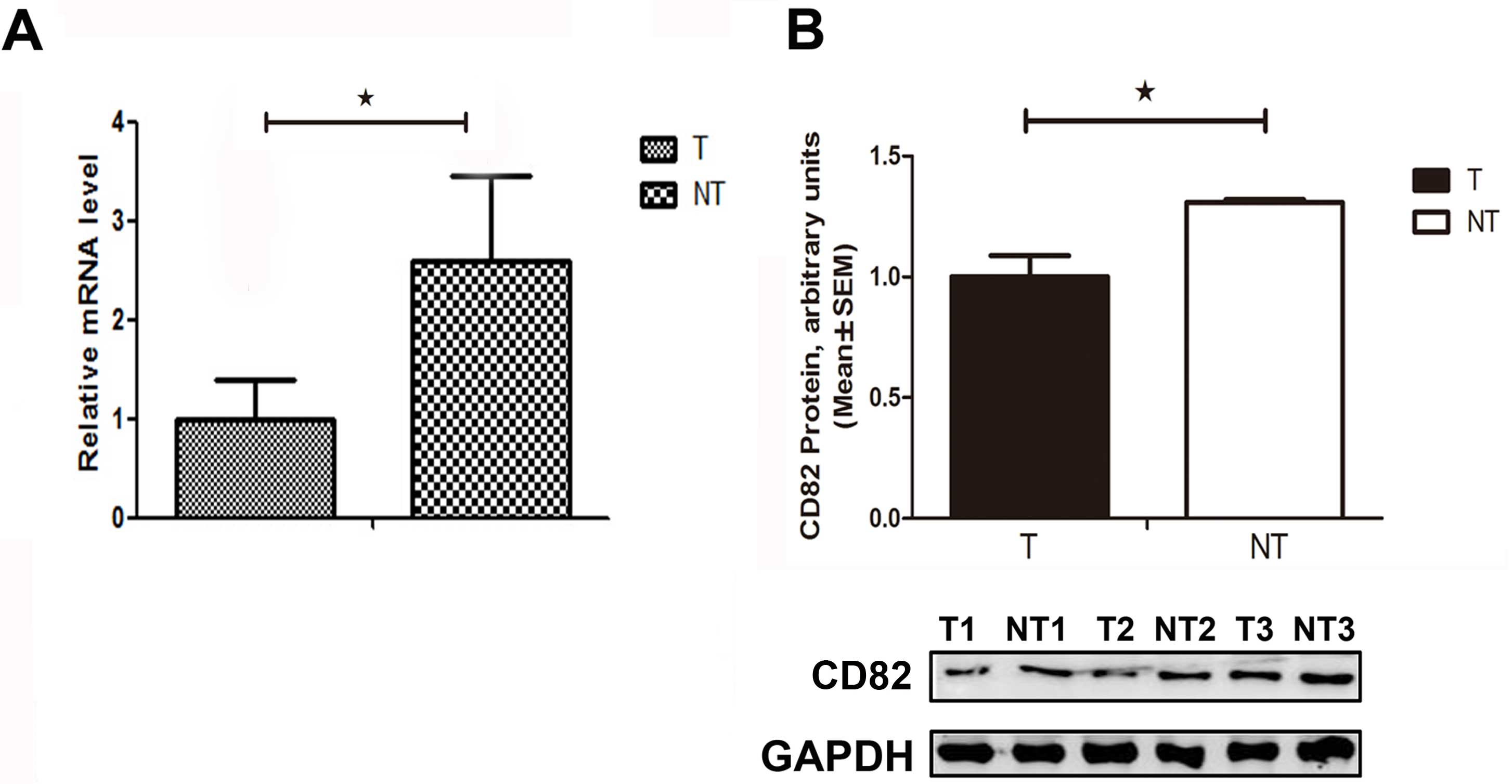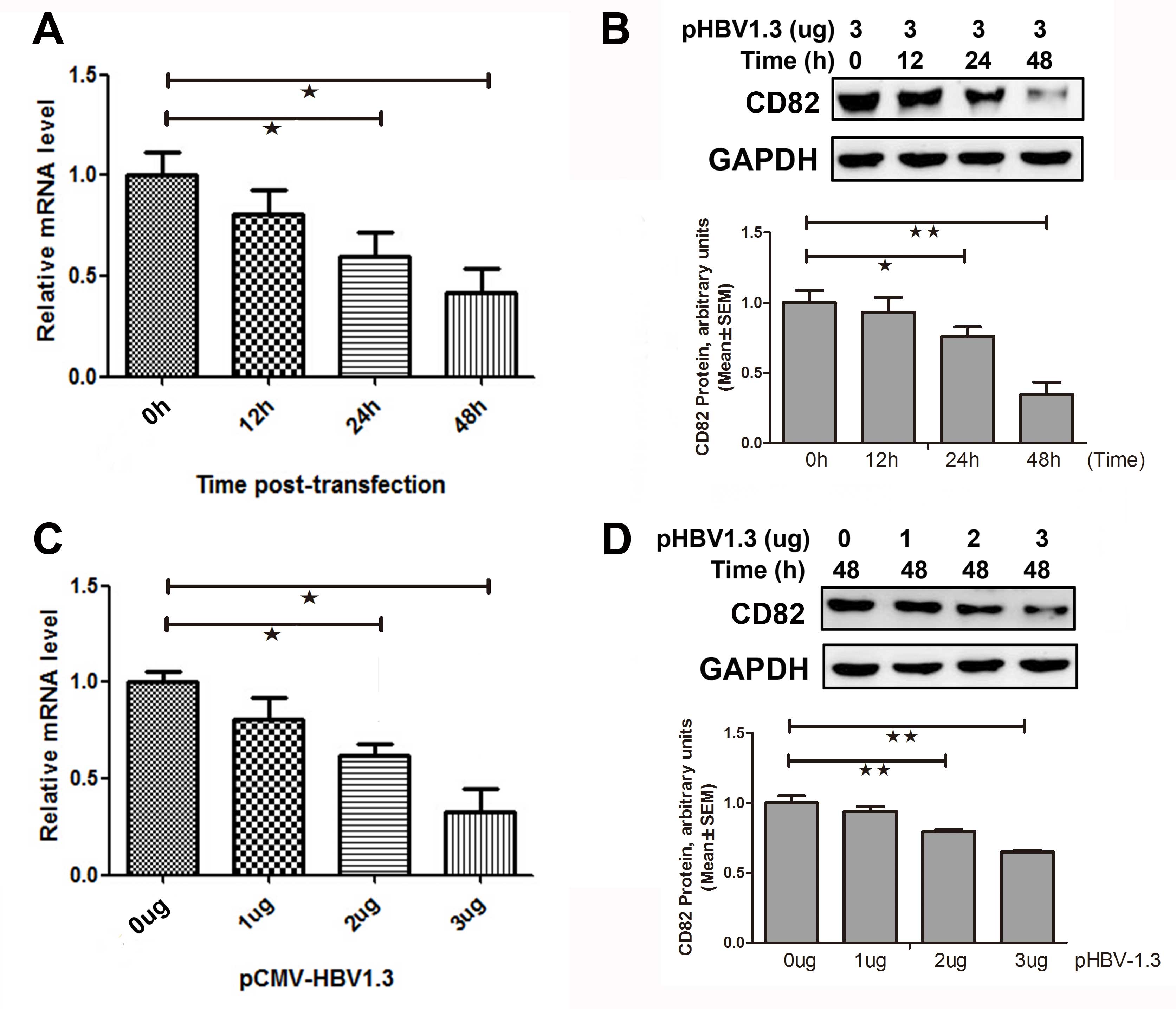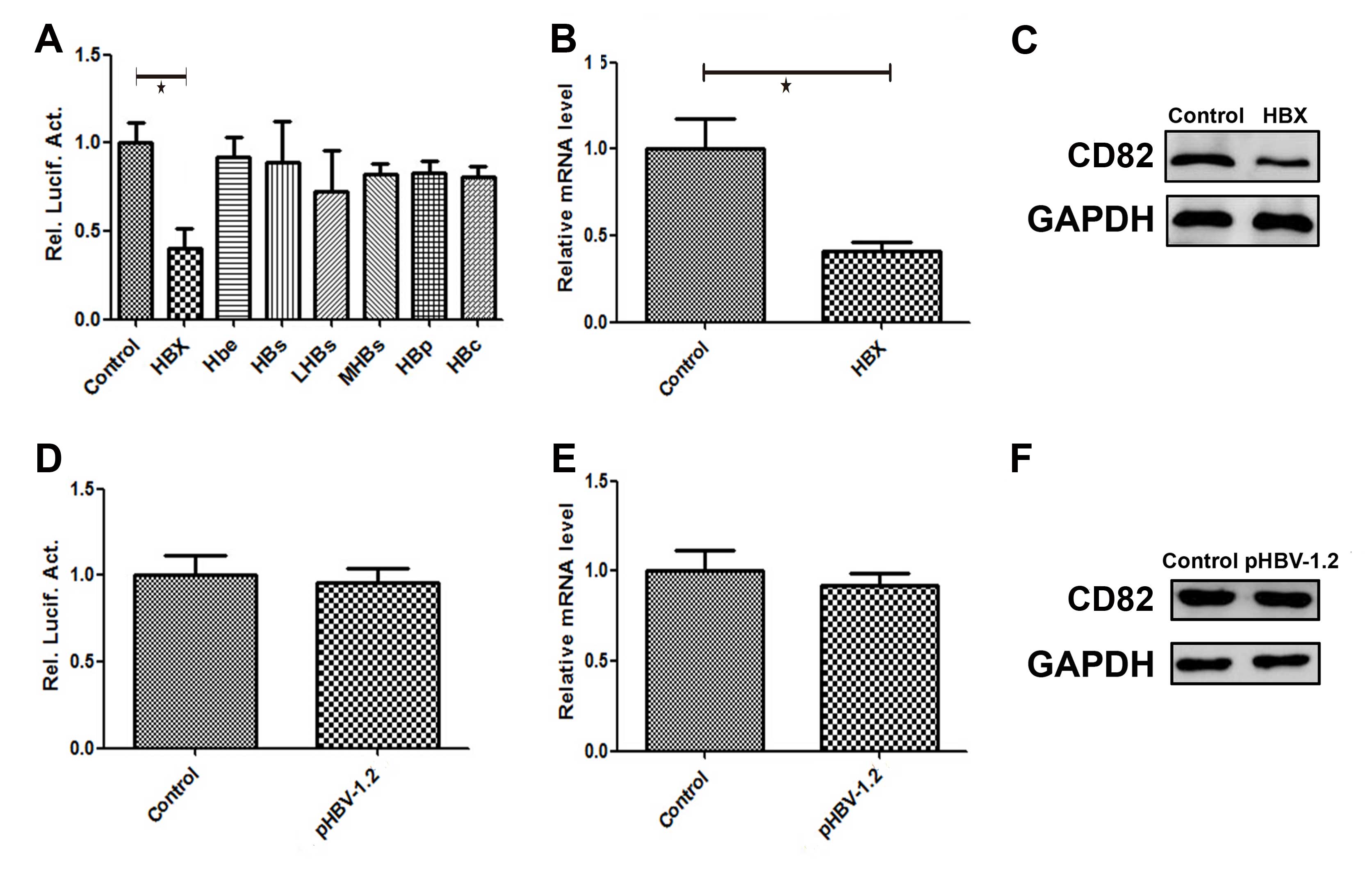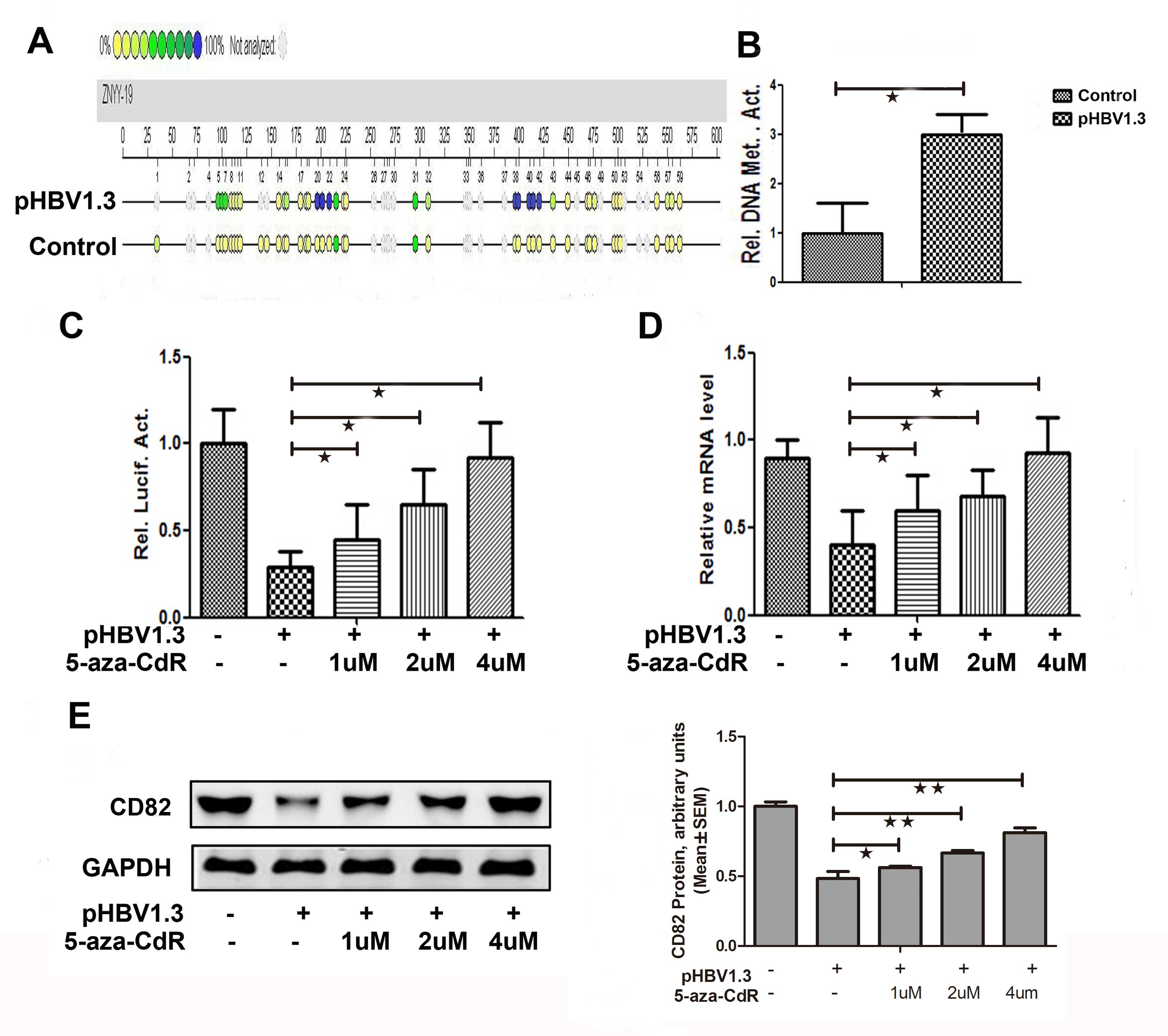Hepatitis B virus inhibits the expression of CD82 through hypermethylation of its promoter in hepatoma cells
- Authors:
- Published online on: August 14, 2014 https://doi.org/10.3892/mmr.2014.2495
- Pages: 2580-2586
Abstract
Introduction
Hepatitis B virus (HBV) infection can cause severe liver diseases, including chronic hepatitis and hepatocellular carcinoma (HCC) (1). HBV infection remains a major health problem, with 2 billion people infected worldwide, of which 400 million are chronically infected (1). However, the complex mechanism by which HBV infection leads to the development of HCC remains unclear.
It has previously been reported that the HBV X protein (HBx) has a crucial role in hepatocarcinogenesis (2). HBx is a multifunctional protein that activates numerous viral and cellular genes, modulates cellular signal transduction pathways, and regulates cell proliferation and apoptosis (3). Previous studies have demonstrated that HBx regulates viral gene expression through the transactivation of HBV enhancers, and may also mediate the expression of genes in infected cells in order to facilitate tumorigenesis (4–7).
DNA hypermethylation is a mechanism that may disrupt the normal function of tumor suppressor genes. Aberrant methylation of normally unmethylated CpG islands has been reported as a relatively frequent event in immortalized and transformed cells (4–7).
CD82 is a recently discovered tumor metastasis suppressor gene, the expression level of which has been shown to be highly associated with deterioration, invasion, and metastasis of numerous human epithelial cells (7,8). The association between CD82 expression in HCC and HBV infection has not yet been reported. In the present study, the mRNA and protein expression levels of CD82 in HCC tissues were determined, and the association between CD82 and HBV was analyzed using in vitro assays.
Materials and methods
Patients and specimens
For the present study a total of 27 patients with HCC, admitted to Zhongnan Hospital of Wuhan University (Wuhan, China) between January 2010 and December 2012, were retrospectively studied. HCC was defined as liver cancer using both pathological and clinical data. All of the patients tested positive for hepatitis B surface antigen for >6 months. HCC tissues and adjacent non-tumor tissues were obtained through a surgical procedure. Written informed consent was obtained from each patient. Ethical approval was granted by the Medical Ethical Committee of the Zhongnan Hospital, Wuhan University (Wuhan, China) and conducted according to the principles expressed in the Declaration of Helsinki.
Plasmid construction
To construct the HBV plasmid pCMV-HBV-1.3, a terminally redundant (1.3 × copy), replication-competent HBV genome (subtype adw; nucleotides 957–1952; GenBank accession number: AF100309) was inserted into the pUC19 (Promega Corporation, Madison, WI, USA), as described by previous methods (9). The recombinant plasmid pCMV-HBV contained the wild-type HBV 1.1-mer overlength genomic sequence, and the synthesis of the pre-genomic RNA was driven by the cytomegalovirus (CMV) promoter. A 1870 bp promoter construct of the CD82 gene, relative to the transcriptional initiation site (nt -1870-0), was cloned into the pGL3 luciferase construct (Promega Corporation) and generated from human genomic DNA by polymerase chain reaction (PCR). The resulting construct was confirmed by DNA sequencing of CD82. A plasmid carrying 1.3-fold length of HBV genome (pCMV-HBV1.3) and the same plasmid with a stop codon for amino acid 7 of HBx (pCMV-HBV1.2) were generated from pCMV-HBV1.3, which was obtained from Dr. Robert Schneider (New York University Medical Center, New York, USA). To study the role of HBx in the hypermethylation function, the effects of pCMV-HBV1.3 and pCMV-HBV1.2 on the expression of CD82, were compared. There are seven proteins in the HBV genome, including HBX, Hbe, HBs, LHBs, MHBs, HBP and HBc. The pCMV-HBX, Hbe, HBs, LHVs, MHBs, HBP and HBc plasmids were constructed using the pCMV-tag2B vector. To evaluate the predominant protein involved in the regulation of CD82, these plasmids were each transfected and the expression of CD82 was subsequently analyzed. The plasmid pCMV-pblue and the promoter pGL3-flag-2b were constructed and were used as controls.
Cell culture
HepG2 hepatoma cell lines were obtained from the Cell Bank of the Chinese Academy of Sciences (Shanghai, China), and were characterized by mycoplasma detection, isozyme detection, DNA fingerprinting, and cell-vitality detection. The cells were cultured in the recommended media supplemented with 10% (vol/vol) fetal bovine serum (Gibco-BRL, Carlsbad, CA, USA), 100 U/ml penicillin (Invitrogen Life Technologies, Carlsbad, CA, USA), and 100 μg/ml streptomycin (Invitrogen Life Technologies) at 37°C in 5% CO2.
Transfection
All transfections were performed using Lipofectamine® 2000 reagent (Invitrogen Life Technologies) according to the manufacturer’s instructions. HepG2 cells were co-transfected with different concentrations of the pCMV-HBV1.3 plasmid and the promoter pGL3-CD82 (pHBV-1.3 group). The relative mRNA and protein expression levels of CD82 were detected 0, 12, 24, and 48 h post-transfection. HepG2 cells were co-transfected with either the pCMV-HBx, pCMV-Hbe, pCMV-HBs, pCMV-LHBs, pCMV-MHBs, pCMV-HBP or pCMV-HBc plasmid and the promoter pGL3-CD82. As a control, HepG2 cells were co-transfected with the plasmid pCMV-pblue and the corresponding promoter pGL3-flag-2b. Furthermore, HepG2 cells were transiently co-transfected with pCMV-HBV-1.2 and the promoter pGL3-CD82 (pHBV-1.2 group). The luciferase activities, and the relative mRNA and protein expression levels of CD82 were detected 48 h post-transfection.
Reporter assays
For the luciferase assay, HepG2 cells were co-transfected with the plasmid and the promoter. The cell lysates were prepared, and the luciferase activity was measured using a luciferase assay system (Promega Corporation), 48 h post-transfection. All transfections were performed using Lipofectamine 2000 reagent, according to the manufacturer’s instructions. The cell lysates (10 μl) and luciferase assay substrates (50 μl) were mixed, and the fluorescence intensity was detected using a luminometer (Promega Corporation). A Renilla lucierase reporter vector, pRL-TK, was used as an internal control. the luciferase activity was measured in each sample 48 h after transfection using the dual-luciferase reporter assay system (Promega Corporation) and Renilla luciferase activities were determined as internal controls for transfection efficiency. The assays were performed in triplicate and expressed as the means ± standard error of the mean relative to the vector control, which was set as 100%. All of the transfection experiments were performed at least three times.
Reverse transcription quantitative PCR (qPCR)
For the analysis of mRNA levels, total RNA was extracted using TRIzol® reagent (Invitrogen Life Technologies) according to the manufacturer’s instructions. Quantification of total RNA was performed using a Nanodrop™ spectrophotometer (Thermo Fisher Scientific, Waltham, MA, USA) at 260 and 280 nm. cDNA was synthesized using a cDNA Synthesis kit (Toyobo, Osaka, Japan). Amplification was performed using the iQ™5 Quantitative PCR system (Bio-Rad, Hercules, CA, USA) with SYBR® Green Master Mix (Toyobo). GAPDH was used for normalization of the relative expression levels. The sequence of the primers, synthesized by Invitrogen Life Technologies, used were as follows: CD82 forward, 5′-AGGATGCCTGGGACTACGTG-3′, and reverse, 5′-GCTCAGCGTTGTCTGTCCAGT-3′; GAPDH forward, 5′-TCGTGCGTGACATTAGGAG-3′, and reverse, 5′-GTCAGGCAGCTCGTAGCTCT-3′. The PCR conditions were set as follow: 95°C for 30 sec, 55°C for 30 sec, and 72°C for 1 min, for 40 cycles. The cycle threshold (Ct) indicated the fractional cycle number at which the PCR product was first detected above a fixed threshold. Relative mRNA levels were determined using the 2−ΔΔCt method.
Western blot analysis
For the detection of protein expression levels, cytoplasmic protein extracts were prepared from the HCC and adjacent non-tumor tissues of the HCC patients. Tissue samples were homogenized in a WCE buffer, which contained 26 mM HEPES (pH 7.7), 0.3 M NaCl, 1.5 mM MgCl2, 0.2 mM EDTA, 0.1% Triton X-100, 0.5 mM dithiothritol, 20 mM glycerophosphate, 0.1 mM Na3VO4, 2 g/ml leupeptin, 2 g/ml aprotinin, 1 mM pehnylmethylsulfonyl fluoride and a protease inhibitor cocktail (Boehringer, Mannheim, Germany). The tissue suspension was rotated at 4°C for 10 min and the supernatants were collected. The protein concentration of each sample was detected by Bradford assay (Bio-Rad Laboratories, Hercules, CA, USA). Protein (100 μg) from each sample was separated by SDS-PAGE (4% stacking and 10% separating gels) followed by an overnight transfer onto polyvinylidene fluoride membranes (Millipore, Boston, MA, USA). The membranes were then blocked for 1 h with phosphate-buffered saline containing 0.05% Tween® 20 and 5% nonfat dry milk, followed by an overnight incubation at 4°C with polyclonal rabbit anti-human CD82 antibody (1:2,000 dilution; Cell Signaling Technology, Inc., Danvers, MA, USA). The bound antibodies were revealed using a peroxidase-labeled secondary antibody (1:5,000 dilution; Millipore) and visualized with enhanced chemiluminescence detection reagents. The intensity of each band was quantified using MCID Elite Software (InterFocus Imaging Ltd., Linton, UK).
Methylation assay of the CD82 gene promoter region
To determine the effects of hypermethylation of a CpG island within the CD82 promoter, HepG2 cells were transiently co-transfected with the plasmid pCMV-HBV1.3 and the promoter CD82. Bisulfite conversion of genomic DNA was performed using an EpiTect Bisulfite kit (Qiagen, Basel, Switzerland), according to the manufacturer’s instructions. Primers were designed for the CD82 promoter, to cover the regions containing the CpG islands. The selected amplicon was located in the core regulatory regions of the promoter, which covered the two glucocorticoid response elements. The primers were designed using MethPrimer software (10). For PCR amplification, a T7-promoter tag sequence was added to the reverse primer, and a 10-mer tag sequence was added to the forward primer to balance the PCR primer length. The following PCR conditions were used for the amplification of the bisulfite-treated genomic DNA: one cycle, 94°C for 4 min; 45 cycles, 94°C for 20 sec; 56°C for 30 sec; 72°C for 1 min; and one cycle, 74°C for 3 min. Unincorporated dinucleotide triphosphates were removed by shrimp alkaline phosphatase (Sequenom Inc., San Diego, CA, USA) treatment. Approximately 2 μl of the PCR product was used as the template for the transcription reaction, using T7 Polymerase Buffer and 20 U of T7 R&DNA™ polymerase (Epicentre, Madison, WI, USA). In the same step, RNase A (Sequenom Inc.) was added to cleave the in vitro transcripts (T-cleavage assay). The samples were then diluted with H2O to a final volume of 7 μl and incubated at 37°C for 3 h. Following the incubation, a further 20 μl of double-distilled H2O was added to each sample. Phosphate backbone conditioning was then performed through the addition of 6 mg of Clean Resin (Sequenom Inc.) prior to matrix-assisted laser desorption/ionization time-of-flight (MALDI-TOF) mass spectrometry analysis. A total of 12 nl of the RNase A-treated product was robotically dispensed onto a silicon matrix of preloaded chips (SpectroCHIP®; Sequenom Inc.), and the mass spectra were collected using a MassARRAY® Compact MALDI-TOF (Sequenom Inc.). The methylation ratios of the spectra were generated using EpiTYPER software version 1.0 (Sequenom Inc.).
Statistical analyses
The data are presented as the means ± standard deviation. Student’s t-tests were applied for the comparisons between the groups; a P<0.05 was considered to indicate a statistically significant difference. All statistical analyses were performed using the statistical software SPSS version 17.0 for Windows (SPSS Inc., Chicago, IL, USA).
Results
Expression levels of CD82 in the HCC tissues and adjacent non-tumor tissues
The relative mRNA expression level of CD82 was significantly decreased by 46% (P=0.029), as compared with that in the adjacent non-tumor tissues (Fig. 1A). The relative CD82 protein expression level was significantly decreased in the HCC tissues, as compared with that in the adjacent non-tumor tissues (Fig. 1B). These results suggest that CD82 expression was suppressed in HCC tissues, and CD82 gene deletion may be an ideal target for gene therapy in the treatment of HCC.
HBV inhibits CD82 mRNA and protein expressions in vitro
HepG2 cells were transiently co-transfected with 3 μg pCMV-HBV-1.3 plasmid The relative mRNA and protein expression levels of CD82 were determined 0, 12, 24, and 48 h post-transfection. As shown in Fig. 2A, the mRNA expression levels of CD82 were significantly decreased by 32 (P=0.041) and 55% (P=0.041) 24 and 48 h post-transfection respectively, as compared to 0 h post-transfection. The CD82 protein expression was also significantly decreased 24 h post-transfection (0.76±0.07 vs. 1.00±0.009, P=0.014) and 48 h post-transfection (0.34±0.09 vs. 1.00±0.09, P=0.001), as compared to 0 h post-transfection (Fig. 2B).
HepG2 cells were transiently co-transfected with various concentrations of the plasmid pCMV-HBV1.3, and the relative mRNA and protein expression levels of CD82 were determined 48 h post-transfection. CD82 mRNA expression was significantly decreased by 39 (P=0.031) and 52% (P=0.015) at the concentrations of 2 and 3 μg pCMV-HBV1.3 respectively, as compared to 0 μg pCMV-HBV1.3 (Fig. 2C). As shown in Fig. 2D, the protein expression levels of CD82 were significantly decreased when treated with 2 μg pCMV-HBV1.3 (0.79±0.02 vs. 1.00±0.05, P=0.008) or 3 μg pCMV-HBV1.3 (0.65±0.01 vs. 1.00±0.05, P=0.001), as compared to 0 μg pCMV-HBV1.3. These results indicate that HBV inhibited the mRNA and protein expression levels of CD82 in vitro.
Effects of HBx on CD82 promoter activity, mRNA and protein expression
HepG2 cells were transiently co-transfected with the following plasmids: pCMV-HBx, pCMV-Hbe, pCMV-HBs, pCMV-LHBs, pCMV-MHBs, pCMV-HBP, pCMV-HBc and the promoter pGL3-CD82. The luciferase activity of CD82 was detected 48 h post-transfection. The plasmid pCMV-pblue and the corresponding promoter pGL3-flag-2b was constructed and used as a control. As shown in Fig. 3A, the luciferase activity of CD82 was significantly decreased by 60% (P=0.005) following co-transfection with the plasmid pCMV-HBx and the promoter pGL3-CD82 (HBx group), as compared with the luciferase activity of the control group. HepG2 cells were transiently transfected with the following plasmids: pCMV-HBx, pCMV-Hbe, pCMV-HBs, pCMV-LHBs, pCMV-MHBs, pCMV-HBP and pCMV-HBc. The plasmid pCMV-pblue was used as a control. The mRNA and protein expression levels of CD82 were detected 48 h post-transfection. The CD82 mRNA expression level in the HBx group was decreased by 62% (P=0.024), as compared with the control group (Fig. 3B). As shown in Fig. 3C, the protein expression level of CD82 in the HBx group was also significantly decreased, as compared with the control group.
HepG2 cells were transiently co-transfected with the plasmid pCMV-HBV-1.2 and the promoter pGL3-CD82 (pHBV-1.2 group). The luciferase activity, and the relative mRNA and protein expression levels of CD82 were detected 48 h post-transfection. The plasmid pCMV-pblue and the corresponding promoter pGL3-flag-2b was constructed and used as a control. As shown in Fig. 3D, there was no difference in the luciferase activity of CD82 in the pHBV-1.2 group, compared to the control group. The mRNA and protein expression levels of CD82 were detected 48 h post-transfection. tHe plasmid pCMV-pblue was used as a control. As shown in Fig. 3E and F, there was no difference in the mRNA and protein expressions of CD82 in the pHBV-1.2 group, compared to the control group.
Effects of HBV on CD82 expression by inducing CD82 promoter methylation
The overall methylation level of the CD82 promoter in the pHBV-1.3 group was significantly increased by 3-fold (P=0.018), as compared with that in the control group (Fig. 4A and B). As shown in Fig. 4C, the promoter activities of CD82 was increased by 1.53 (P=0.032), 2.17 (P=0.019) and 3.14-fold (P=0.027) when treated with 1, 2 and 4 μM of 5-aza-CdR respectively, in the pHBV-1.3 group. The CD82 mRNA expression levels were increased by 1.36 (P=0.033), 1.59 (P=0.032) and 2.27-fold (P=0.024) when treated with 1, 2 and 4 μM of 5-aza-CdR respectively, in the pHBV-1.3 group (Fig. 4D). The protein expression levels of CD82 were also increased in the pHBV-1.3 group, when treated with 1 μM (0.56±0.01 vs. 1.00±0.03, P−=0.040), 2 μM (0.66±0.02 vs. 1.00±0.03, P=0.002), or 4 μM (0.81±0.03 vs. 1.00±0.03, p<0.001) of 5-aza-CdR (Fig. 4E). These results indicate that the inhibitor of methylation 5-aza-CdR could reverse the effects of HBV on CD82. Therefore, it may be hypothesized that HBV may affect the expression of CD82 by inducing CD82 promoter methylation.
Discussion
CD82 is a tumor metastasis suppressor gene and one of four transmembrane glycoprotein superfamily members. The CD82 gene is located on the human chromosome 11p11.2, and it encodes a 267 amino acid protein molecule, the molecular weight of which is 29 kDa (11). The downregulation of CD82 may be an important factor in the development of liver cancer, however the exact mechanisms by which this occurs remain to be elucidated. Previous studies have shown that CD82 inhibits the metastasis of a vast majority of tumors, and is associated with tumor invasiveness (11). CD82 expression has also been shown to be highly associated with deterioration, invasion, and metastasis of numerous human epithelial cells (10,11). However, the association between the CD82 gene and HBV in HCC has not yet been determined. Whether HBV can regulate the development of liver cancer through influencing CD82 gene expression is still unclear (12,13).
DNA methylation is a chemical modification method of the eukaryotic genome. DNA methylation is the process by which methyl groups from S-adenosylmethionine are transferred to the 5′ cytosine molecule of a carbon ring, resulting in the formation of a 5-methylcytosine. Methylation is catalyzed by the DNA methyltransferase enzyme. The repeated sequences of certain genes in healthy cells have high methylation levels which prevent reactivation of transcription factors, resulting in genomic stability (14–16). If the normal methylation of somatic cells changes, known as whole genome hypomethylation, it may lead to uncontrolled cell growth. Changing site-specific methylation, for example tumor suppressor gene promoter CpG island hypermethylation, may lead to tumorigenesis. This change is an epigenetic characteristic of tumor cells, and is present in almost all types of tumors (17–19). There are numerous key cancer gene promoter regions which are involved in DNA repair, cell cycle regulation, resistance formation and tumor invasion, metastasis and angiogenesis, and the presence of high methylation status may be a tumor characteristic (17). Previous studies have determined that hypermethylation of the promoter region leads to the inactivation of some tumor suppressor genes, which is a common feature of human tumors (18). Furthermore, CD82 hypermethylation may lead to the inactivation of tumor suppressor genes. The localized hypermethylation of tumor cells generally occurs in the promoter region of the gene, which may result in the silenced expression of the gene (19). A previous study found that in the development of liver cancer, some viruses could cause tumor suppressor gene promoter hypermethylation, resulting in the transcriptional interference of tumor suppressor gene expression, abnormal cell proliferation and cancer development (20). Considering the close association between DNA methylation and human cancer development, especially due to CpG island methylation of tumor suppressor genes, DNA methylation and epigenetics have recently become an important area of study.
Liver cancer is a common primary tumor, with characteristics including recurrence, metastasis, high mortality and poor prognosis (21). Previous studies have reported that 80% of liver cancer cases are accompanied by HBV infection (22,23). It is important for future research to identify specific biomarkers for the early diagnosis of liver cancer, as well as looking for a new target for treatment. The present study demonstrated that aberrant epigentic modifications in the promoter of CD82 were induced by HBx. Hypermethylation of the promoter of CD82 lead to the reduction of expression, which may subsequently participate in the prgression of HCC. The results indicated that induciton of CD82 expression by treatment with the methyl enzyme inhibitor 5-aza-CdR, could be a potential treatment for HBV-induced HCC. In conclusion, the present study provided a theoretical basis for the clinical treatment of HBV-induced cancer.
Acknowledgements
This work was supported by grants from the National Natural Science Foundation of China (nos. 30872491/C160402, 81372552 and 81172349/H1617). The authors would like to thank all the gastroenterologists and investigators in the Research Center of Digestive Diseases.
References
|
Benhenda S, Cougot D, Buendia MA and Neuveut C: Hepatitis B virus X protein molecular functions and its role in virus life cycle and pathogenesis. Adv Cancer Res. 103:75–109. 2009.PubMed/NCBI | |
|
Feitelson MA and Lee J: Hepatitis B virus integration, fragile sites, and hepatocarcinogenesis. Cancer Lett. 252:157–170. 2007. View Article : Google Scholar : PubMed/NCBI | |
|
Chan DW and Ng IO: Knock-down of hepatitis B virus X protein reduces the tumorigenicity of hepatocellular carcinoma cells. J Pathol. 208:372–380. 2006. View Article : Google Scholar : PubMed/NCBI | |
|
Cheng AS, Wong N, Tse AM, Chan KY, Chan KK, Sung JJ and Chan HL: RNA interference targeting HBx suppresses tumor growth and enhances cisplatin chemosensitivity in human hepatocellular carcinoma. Cancer Lett. 253:43–52. 2007. View Article : Google Scholar | |
|
Zhang X, Zhang H and Ye L: Effects of hepatitis B virus X protein on the development of liver cancer. J Lab Clin Med. 147:58–66. 2006. View Article : Google Scholar : PubMed/NCBI | |
|
Moon EJ, Jeong CH, Jeong JW, Kim KR, Yu DY, Murakami S, Kim CW and Kim KW: Hepatitis B virus X protein induces angiogenesis by stabilizing hypoxia-inducible factor-1alpha. FASEB J. 18:382–384. 2004.PubMed/NCBI | |
|
Robinson WS: Molecular events in the pathogenesis of hepadnavirus-associated hepatocellular carcinoma. Annu Rev Med. 45:297–323. 1994. View Article : Google Scholar : PubMed/NCBI | |
|
Nephew KP and Huang TH: Epigenetic gene silencing in cancer initiation and progression. Cancer Lett. 190:125–133. 2003. View Article : Google Scholar : PubMed/NCBI | |
|
Li J, Lin S, Chen Q, Peng L, Zhai J, Liu Y and Yuan Z: Inhibition of hepatitis B virus replication by MyD88 involves accelerated degradation of pregenomic RNA and nuclear retention of pre-S/S RNAs. J Virol. 84:6387–6399. 2010. View Article : Google Scholar : PubMed/NCBI | |
|
Li LC and Dahiya R: MethPrimer: designing primers for methylation PCRs. Bioinformatics. 18:1427–1431. 2002. View Article : Google Scholar : PubMed/NCBI | |
|
Dong JT, Lamb PW, Rinker-Schaeffer CW, Vukanovic J, Ichikawa T, Isaacs JT and Barrett JC: CD82, a metastasis suppressor gene for prostate cancer on human chromosome 11p11.2. Science. 268:884–886. 1995. View Article : Google Scholar | |
|
Miranti CK: Controlling cell surface dynamics and signaling: how CD82/CD82 suppresses metastasis. Cell Signal. 21:196–211. 2009. View Article : Google Scholar : PubMed/NCBI | |
|
Ai X, Zhang X, Wu Z, Ma X, Ju Z, Wang B and Shi T: Expression of CD82/CD82 and MRP-1/CD9 in transitional cell carcinoma of bladder. J Huazhong Univ Sci Technolog Med Sci. 27:79–82. 2007. View Article : Google Scholar : PubMed/NCBI | |
|
Nelson WG, Yegnasubramanian S, Agoston AT, Bastian PJ, Lee BH, Nakayama M and De Marzo AM: Abnormal DNA methylation, epigenetics, and prostate cancer. Front Biosci. 12:4254–4266. 2007. View Article : Google Scholar : PubMed/NCBI | |
|
Dalmay T and Edwards DR: MicroRNAs and the hallmarks of cancer. Oncogene. 25:6170–6175. 2006. View Article : Google Scholar : PubMed/NCBI | |
|
Kent OA and Mendell JT: A small piece in the cancer puzzle: microRNAs as tumor suppressors and oncogenes. Oncogene. 25:6188–6196. 2006. View Article : Google Scholar : PubMed/NCBI | |
|
Zhu J: DNA methylation and hepatocellular carcinoma. J Hepatobiliary Pancreat Surg. 13:265–73. 2006. View Article : Google Scholar : PubMed/NCBI | |
|
Yang B, Guo M, Herman JG and Clark DP: Aberrant promoter methylation profiles of tumor suppressor genes in hepatocellular carcinoma. Am J Pathol. 163:1101–1107. 2003. View Article : Google Scholar : PubMed/NCBI | |
|
Lee S, Lee HJ, Kim JH, Lee HS, Jang JJ and Kang GH: Aberrant CpG island hypermethylation along multistep hepatocarcinogenesis. Am J Pathol. 163:1371–1378. 2003. View Article : Google Scholar : PubMed/NCBI | |
|
Pogribny IP and Rusyn I: Role of epigenetic aberrations in the development and progression of human hepatocellular carcinoma. Cancer Lett. 342:223–230. 2014. View Article : Google Scholar : PubMed/NCBI | |
|
Shiraha H, Yamamoto K and Namba M: Human hepatocyte carcinogenesis (review). Int J Oncol. 42:1133–1138. 2013.PubMed/NCBI | |
|
Li LH, He J, Hua D, Guo ZJ and Gao Q: Lentivirus-mediated inhibition of Med19 suppresses growth of breast cancer cells in vitro. Cancer Chemother Pharmacol. 68:207–215. 2011. View Article : Google Scholar : PubMed/NCBI | |
|
Perz JF, Armstrong GL, Farrington LA, Hutin YJ and Bell BP: The contributions of hepatitis B virus and hepatitis C virus infections to cirrhosis and primary liver cancer worldwide. J Hepatol. 45:529–538. 2006. View Article : Google Scholar : PubMed/NCBI |













